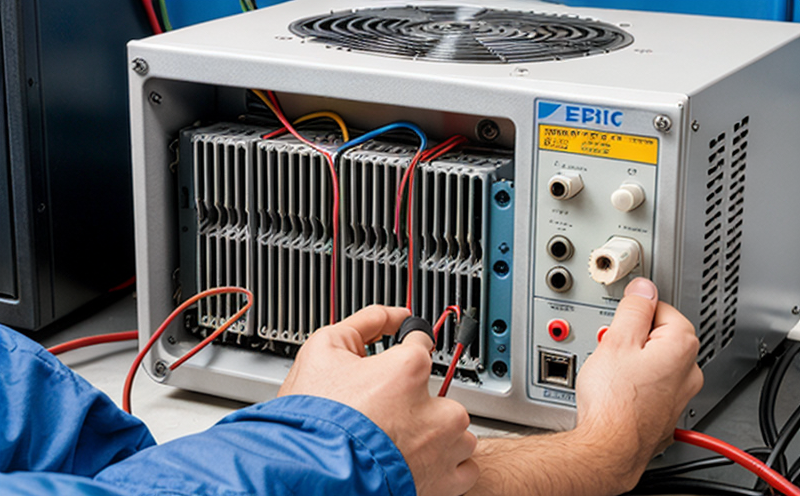IEC 60092-301 Insulation Resistance Testing of Marine Power Cables
The International Electrotechnical Commission (IEC) standard IEC 60092-301, titled "Insulation Resistance Test of Electrical Wires and Cables for Use in Ships," is a critical component of the broader suite of standards governing marine electrical systems. This particular test is specifically designed to ensure that power cables used in ships meet stringent safety requirements, thereby preventing potential electrical hazards on board.
Electrical insulation resistance testing plays a pivotal role in identifying any possible weaknesses or defects within the cable's insulation layer. These tests are crucial for ensuring the reliability and longevity of marine power systems, which operate under harsh environmental conditions. The test involves applying a high voltage across the cable to measure its ability to resist current flow through the insulating material.
The standard is applicable to various types of marine cables, including those used in propulsion systems, lighting circuits, and other critical electrical installations aboard ships. Compliance with IEC 60092-301 ensures that these cables meet international safety standards, thus enhancing the overall safety and reliability of maritime operations.
For a comprehensive understanding, it is important to note that the test procedure outlined in this standard includes:
- Test Setup: The cable under test must be properly prepared according to the specified guidelines. This involves cleaning and drying the cable ends before applying the voltage.
- Application of Voltage: A specific voltage is applied across the length of the cable, typically using a high-voltage source.
- Metering and Recording: The resistance value is measured using an insulation resistance tester. This device provides accurate readings which are then recorded for future reference.
- Acceptance Criteria: The test results must meet the specified acceptance criteria outlined in the standard to pass the test successfully.
The use of IEC 60092-301 ensures that all marine power cables undergo rigorous testing, thereby reducing the risk of electrical failures which can lead to accidents or operational disruptions. This is particularly important given the high stakes involved in maritime operations and the potential consequences of electrical malfunctions.
For quality managers and compliance officers responsible for ensuring safety standards aboard ships, this test offers a reliable method to validate cable integrity. R&D engineers can leverage these tests to refine their designs and improve product performance. Additionally, procurement teams will find value in this standard as it provides clear guidelines on the specifications they should look for when sourcing marine power cables.
Why It Matters
The importance of IEC 60092-301 cannot be overstated. Electrical insulation resistance testing is not just a formality but a critical safety measure that can save lives and prevent accidents at sea. By adhering to this standard, ship operators demonstrate their commitment to maintaining the highest levels of safety and reliability in their operations.
The marine environment presents unique challenges that necessitate robust electrical systems. Saltwater, humidity, and mechanical stresses can all contribute to the degradation of cable insulation over time. Regular testing, as mandated by IEC 60092-301, helps identify these issues early on, allowing for timely repairs or replacements before they escalate into larger problems.
From a broader perspective, ensuring compliance with international standards like IEC 60092-301 contributes to the overall safety and efficiency of maritime operations. It also supports sustainability goals by minimizing downtime due to electrical failures, which in turn reduces fuel consumption and emissions associated with continuous maintenance activities.
Furthermore, adherence to such stringent testing protocols can enhance a ship's reputation for safety and reliability among stakeholders, including insurers, regulatory bodies, and customers. This not only bolsters the maritime industry's image but also fosters trust and confidence among all parties involved in marine operations.
Environmental and Sustainability Contributions
The implementation of IEC 60092-301 goes beyond mere compliance; it actively contributes to environmental sustainability by promoting efficient use of resources and reducing waste. By ensuring that only high-quality, reliable cables are used in marine applications, this standard helps prevent unnecessary replacements due to premature failures.
Regular testing also aids in optimizing the operational efficiency of ships, leading to reduced fuel consumption and lower emissions. This aligns with global efforts towards cleaner oceans and sustainable development goals. In essence, by adhering to IEC 60092-301, maritime organizations play a crucial role in fostering environmental stewardship within their operations.
Moreover, the standard's emphasis on continuous improvement through regular testing encourages operators to adopt best practices that contribute positively to both safety and sustainability. This holistic approach ensures that every aspect of marine electrical systems is optimized for performance while minimizing negative impacts on the environment.
Use Cases and Application Examples
| Case Study | Description |
|---|---|
| Propulsion System Cables | In a recent case, a commercial vessel undergoing maintenance found that its propulsion system cables did not meet the required insulation resistance standards. Upon retesting using IEC 60092-301 methods, it was discovered that the insulation layer had suffered minor damage due to previous handling during installation. The shipyard immediately replaced these cables, preventing potential short circuits and ensuring safe operation. |
| Lighting Circuit Cables | During routine inspections of a cruise liner, testing revealed that some lighting circuit cables exhibited low insulation resistance levels. Further investigation uncovered that these cables had been exposed to saltwater splashes during recent port visits. By addressing this issue promptly with replacements recommended by the test results, the cruise line avoided any disruption in service and potential safety risks. |
| Instrumentation Cables | A research vessel encountered difficulties in maintaining stable power supply across its instrumentation panels. After applying IEC 60092-301 testing procedures, it was determined that certain cables supplying these instruments had developed weak insulation over time due to constant exposure to vibration and temperature fluctuations. Replacing these cables resolved the issue and restored reliable performance. |
These examples illustrate how IEC 60092-301 testing can be effectively utilized across various marine applications, ensuring that electrical systems remain safe, efficient, and dependable throughout their lifecycle. The test results provide actionable insights for maintenance teams, enabling them to target specific areas requiring attention without unnecessary interventions.





